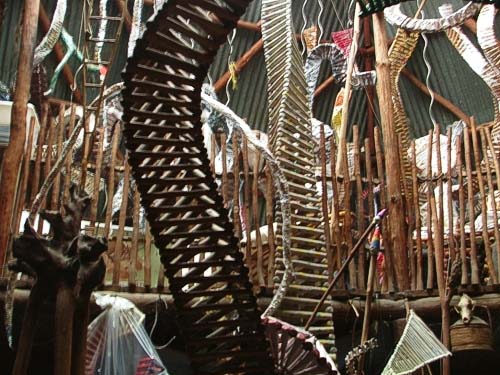View current page
...more recent posts
Nancy Burson was a digital imaging pioneer (art gallery variety) and her omission from the Whitney's BitStreams show last year was just one more example of that show's 30-something parochialism. That said, she kind of lost her way when she started taking photos of people with craniofacial deformities (can you say...exploitation?), and looking back at her classic work, it appears that the tech world has passed her by. Nowadays anyone with Photoshop can combine a man's face with a gibbon's (e.g., Will Self's Great Apes book cover from a few years ago), or give someone a bulbous forehead. And I always thought her "aging software" was a bit of a scam--taking what a police sketch artist does intuitively and dressing it up with pseudoscientific bells and whistles. Nevertheless, her morph of Reagan and Brezhnev (with a pinch of Thatcher, Mitterand, and Deng) is still a grabber. Also noteworthy is her Ordinaires CD cover, where the nine band members merge into a blandly smiling whole.
A website for her current retrospective is here, slow-loading Flash intro and all.
From a Salon Premium piece today, arguing that U.S. Supreme Court Justice Kennedy should recuse himself from the case on mandatory school drug testing:
Before the court was a school district's regulation requiring drug tests of students involved in any extracurricular activity. Although there was no reason to suspect that the plaintiff, Lindsay Earls, had ever used drugs, she was called out of choir and tested -- specifically, ordered to urinate under a teacher's supervision. Earls passed, but brought suit against what she believes was an invasion of privacy and an unconstitutional search.
"Most surprising," said the New York Times, "was Justice Kennedy's implied slur on the plaintiffs." The justice imagined a school district with a "drug testing school" and a "druggie school," and told the lawyer representing the Earls family that no parent would send a child to the druggie school "except maybe your client." This was remarkable in two ways. First, it was indeed a slur: Lindsay Earls had passed the drug test, and her cause was not drugs but the Fourth Amendment. Second, the very irrationality of Kennedy's remarks, coupled with his demeanor -- the Boston Globe described him as red with emotion as he launched his "bitter verbal attack" -- betrayed an uncontainable anger toward a litigant that is entirely absent from Supreme Court arguments on even the most heinous murder cases.
Evidently Kennedy's fixated on the perceived moral failings of high school students right now. According to a recent article on cnn.com, he was disappointed by the "lack of moral outrage" of some Muslim students following the 9/11 attacks on the United States. He also disliked hearing that other kids (presumably non-Muslim) thought the 9/11 attacks were payback for some very bad U.S. policies abroad. Therefore, he's created an American Bar Association-sponsored program, in partnership with First Lady Laura Bush (so much for separation of powers), to teach kids about "fundamental values and universal moral precepts." The program sends lawyers and judges to high schools to talk about "core democratic values" in light of the terrorist attacks.
Yet if there are high school students who can see the connection between 9/11 and US support of oppressive regimes abroad, thankfully, there will be high school students who can recognize a pompous, belligerent, propagandizing hypocrite when they see one. Should they should listen to a member of the 5-person Supreme Court majority that installed a president by judicial fiat on the subject of "democracy"? Should they take the advice of a man who insults kids--in a red, slobbering rage--when they actually stand up for their rights? Perhaps, when he comes to their schools, they'll stand up again and say that maybe their "problem" isn't so much a lack of moral values as disagreement with his.
New additions to my artwork archive have been added this week: several pieces from 2002 (from scans of polaroids--eventually I'll get slides made), and "Volume One" of my early, photorealistic work (and other images, ranging randomly from 1978-94). Also, my review of Ross Knight's 1999 solo show has been added to the writing archive.
Charles Stagg lives in a home he built for himself in the woods outside Vidor, Texas. A Klan stronghold near the Louisiana border, Vidor (pronounced "vy der") is also the ancestral home and namesake of the Hollywood film director King Vidor (pronounced "vee dor"), who filmed Ayn Rand's The Fountainhead. Like Howard Roark in that movie, Stagg has a vision and is willing to go it alone until it's recognized.
UPDATE: Below is a more recent photo of Charles Stagg in his studio (inside the dome). The photographer is John Fulbright. More information can be found in the comments to this post.
UPDATE 2: Another website is referenced in the comments with photos of the Stagg house. This (from the 3rd Stagg gallery on that site) is how I remember the studio looking 15 years ago. He has since painted many of the sculptures but I prefere them "raw" like this:

